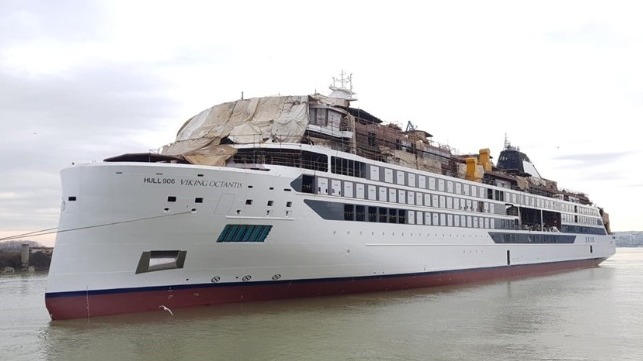Vard Floats Out Viking’s First Expedition Cruise Ship

Viking’s first cruise ship built for the expedition cruise segment was floated out at Fincantieri’s Vard shipyard in Søviknes, Norway on December 22. Named the Viking Octantis, the hull was moved to the outfitting dock for further construction and interior build-out. The first of two 30,150 gross ton cruise ships Vard is building for Viking, this ship is expected to enter service early in 2022 sailing to Antarctica and North America's Great Lakes.
The Viking Octantis and her sister ship the Viking Polaris, due in mid-2022, represent the line’s entry into exploration cruising. Viking, which operates river and ocean cruise ships, plans to build on its destination focus taking passengers to more exotic destinations on the new ships. It is part of the company’s expansion plan, which also includes the introduction of its first ships cruising on the Mississippi River and a launch of a Chinese cruise operation in partnership with China Merchants Group.
"We are pleased to continue our partnership with Fincantieri's Vard and celebrate this important milestone in the construction of our first expedition vessel," said Torstein Hagen, Chairman of Viking. "In creating 'the thinking person's expedition,' we are perfecting polar expedition cruising, and we will usher in a new era of comfortable exploration in the heart of North America.”
The two expedition cruise ships will each measure 665 feet in length and accommodate 378 passengers. Both ships are designed for a Polar Class 6 rating, meaning they will able to operate during summer and fall in medium first-year ice. In announcing the ships, Viking said the design was small enough to navigate remote polar regions and the St. Lawrence River, while large enough to provide superior handling and stability in the roughest seas.
The design incorporates straight bows, which Viking says will reduce fuel consumption, longer hulls, and fin stabilizers as well as U-tank stabilizers that will decrease rolling by up to 50 percent when the ships are stationary. A dynamic positioning system will enable the ships to remain in place without anchoring.
Among the other unique features of the design is an enclosed, in-ship marina that permits the launch of small excursion crafts through the ship's multiple shell doors. Known as The Hangar, it features an 85-foot slipway that allows guests to embark on RIBs from a flat, stable surface inside the ship, shielded from wind and waves. Each ship will be outfitted with a fleet of zodiacs and two-seater Arctic-tested kayaks plus two 12-seater convertible RIBs. Each ship will also feature two six-guest submarines with 270-degree spherical windows.
Aboard the ships there will be a working research laboratory and instruments that passengers can view displaying data on water quality, oxygen content, plankton composition, and more. There will also be a large auditorium for lectures and entertainment as well as a sunroom that converts into an open-air viewing platform.
